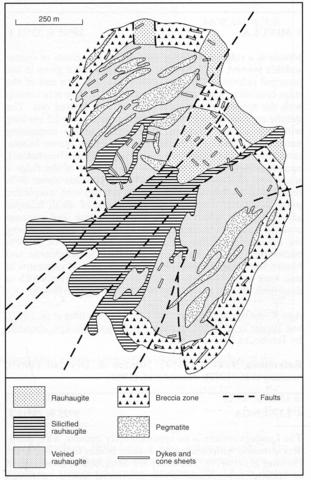stripes
The Nachomba carbonatite forms an isolated hill a little less than 100 m high, 8 km southeast of Kaluwe (No. 180-00-006). It lies in the Uma depression surrounded by lateritic soils that obscure outer contacts. The hill is composed principally of silica-iron oxide rocks produced by the alteration of carbonatite (Bailey, 1960 and 1966) with limited remnants of unaltered carbonatite which is a breccia of coarse- and medium-grained brown and grey carbonatites in a matrix of paler, buff carbonatite which forms a net vein system. Both types of carbonatite are dominantly ankeritic and both contain accessory martite, pyrochlore and barite. Thin quartz veins are widespread, near to which the carbonatite is progressively silicified until a quartz rock results with accessory barite and fluorite. Streaks up to 0.5 m wide of apatite and fluorite are common. There is a little monazite and possible bastnasite in the silicified rocks. West of Nachomba Hill is an area of feldspathic breccia, silica/iron oxide rock and quartz rocks. The breccia is coarse and composed almost entirely of broken feldspar lying in a matrix of comminuted feldspar and ferruginous and sometimes calcareous material. These rocks contain up to 16% K2O.
BAILEY, D.K. 1960. Carbonatites of the Rufunsa Valley, Feira District. Bulletin, Geological Survey of Northern Rhodesia, 5: 1-92.BAILEY, D.K. 1966. Carbonatite volcanoes and shallow intrusions in Zambia. In O.F. Tuttle and J.Gittins (eds) Carbonatites. 127-54. John Wiley, New York.

